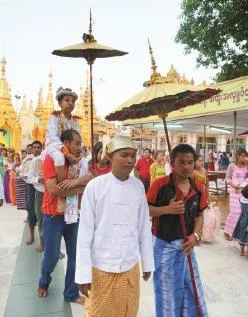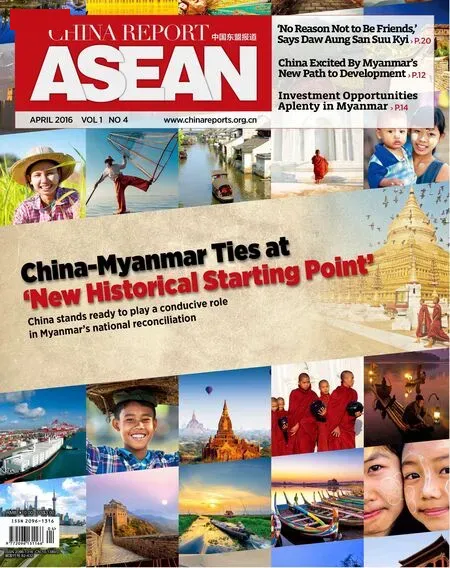Yangon's Golden Pagoda A Magnifcent Tribute to Buddha
2016-09-26ByZoShen
By Zoë Shen
Yangon's Golden Pagoda A Magnifcent Tribute to Buddha
By Zoë Shen
The official name of the Golden Pagoda is the “Shwedagon Pagoda”. “Shwe” in the Myanmar language means “Gold”, while the suffix “Dagon” is the former name of Yangon. In the heart of the country, the Golden Pagoda is the most famous Buddhist pilgrimage site in Myanmar.
During my first visit, I arrived at the pagoda around noon with a keen sense of anticipation and curiosity. There are four entrances, each followed by a fight of stairs that leads to the top of Singuttara Hill, the small hill on which the pagoda sits. A pair of giant leogryphs - traditional lion-like fgures ofen seen at entrances to temples and pagodas in Myanmar - guard each entrance. As is customary in Buddhist holy sites, all visitors are required to remove their shoes, and we walked along the cobblestone road in bare feet, though we hardly noticed. We were overwhelmed by the awe of the shrine. Local worshipers walked with us, sporting local garb known as sarong, a beautiful fabric of checkered patterns (the sarong worn by men is known as longyi, while the version worn by women is called htamain). They held incense sticks, candles and flowers. A common sight in Myanmar, their faces were covered with a yellow-white cosmetic paste known as thanakha. Thanakha is a unique and fascinating part of Myanmar culture, and is commonly applied to the face and sometimes the body, providing skin nourishment, sun protection, anti-infammatory properties and even insect repellent. It also features a very pleasant aroma.
An old bodhi tree - a type of fig tree held sacred in Buddhism - stands at the Southeastern platform near the pagoda itself. The tree, which greeted us as we entered, is said to have been transplanted from the sacred tree nursery on the grounds of Gautama Buddha's Vajrasana Trone Pagoda, a site of deep spiritual importance in Buddhism.

A Tonsure ceremony held for a young monk at the Shwedagon Pagoda.
The shrine is a bowl-shaped building with a high base known as the terrace which lies under the iconic bell shaped roof, which itself is topped by the “inverted alms bowl”, the “turban”, the “inverted and upright lotus petals”, the “banana bud” and finally the “umbrella crown”, all of which contribute to the truly unique design of the Golden Pagoda.
Te base of the shrine is in the shape of an octagon. Te perimeter stretches 433 meters and its total height reaches 112 meters. Real gold plates were used to give the shrine its gold color. Te crown, meanwhile, is topped with thousands of diamonds and rubies. Te highest point even features a 76 carat diamond.
The pagoda is surrounded by a golden forest of small shrines and pagodas, totalling 64 small pagodas and four medium ones. The shape and building materials used vary widely, giving each pagoda its own unique appearance. Some are made of stone, some of wood, some take the shape of a bell and some take the shape of a sail.
A massive, ornate bell hangs in the northeast corner of the shrine, while another bell hangs in a pavilion on the platform's northwest corner. Striking this second bell three times is said to bring good luck and well-being.

The Shwedagon Pagoda, also known as the Golden Pagoda, is a sacred Buddhist site atop Singuttara Hill in Yangon,Myanmar's largest city.
In the days that followed, even when walking around different parts of Yangon, the pagoda was almost always in view. Our tour guide explained to me that it was built by the Mon people, one of Myanmar's earliest known ethnic groups. The Mon people migrated to modern-day Myanmar from modern-day Southern China around the year 2000 B.C., and centered around the Chao Phraya River Basin. Te Mon formed one of the earliest civilizations in the Indochina peninsula, and the Myanmar language alphabet is said to be derived from the Mon script. In terms of when the pagoda was built, there are conflicting claims. Historians and archaeologists maintain that the pagoda was built by the Mon people between the 6th and 10th centuries A.D., but according to legend, the pagoda was established in 588 B.C. Buddhist monks' documents also validate the claim that the pagoda was frst built before Gautama Buddha's incarnation.
According to legend, in 588 B.C., Taphussa and Bhallika - two merchant brothers from Myanmar - met the Lord Gautama Buddha and received eight of the Buddha's hairs. The brothers returned to Myanmar and gave the hairs to their local ruler, King Okkalapa. When the king opened the golden casket in which the brothers had carried the hairs, incredible things happened:
Rays emitted by the hairs spread up to the heavens and down to hell. In turn, the blind saw objects, the deaf heard sounds, the dumb spoke distinctly, and gems rained down until they were knee deep. All the trees of the Himalayas, though not in season, bore blossoms and fruit.
Later on, the pagoda showed another two signs of sanctity. In 1608, Filipe de Brito e Nicote, a Portuguese explorer known as Nga Zinka to the Myanmar people, removed the Dhammazedi bell from the Shwedagon Pagoda and rolled it down Singuttara Hill to a raf on the Pazundaung Creek. Te bell and raft were tied to de Brito's flagship for the journey across the river to Syriam. However, the load proved to be too heavy, and at the confluence of the Bago and Yangon Rivers, the raft broke up and the bell went to the bottom, taking de Brito's ship with it. A similar bell from the pagoda known as the The Maha Gandha (literally meaning great sweet sound) Bell was carried of in 1824 and put on a ship to Kolkata. It met the same fate as the Dhammazedi Bell and fell into the river.
Local devotees pay homage to their nearest pagoda everyday. It is important for Buddhists in Myanmar to know on which day of the week they were born, as this determines their planetary post. Tere are eight planetary posts, as Wednesday is split into two (a.m. and p.m.). They are marked by animals that represent the day. Wednesday afternoon is also known as “Rahu”.Therefore, there are eight zodiac animal signs, each corresponding to a day of the week. Te zodiac animal sign of Sunday is Garuda (a mythical bird), tiger for Monday, lion for Tuesday, tusked elephant for Wednesday (tusk-less elephant for Rahu), rat for Tursday, guinea pig for Friday and dragon for Saturday. The devotees only contribute flowers and fruits to the Buddha who matches their own Zodiac sign.
During a later visit to the pagoda, I went with the intention of paying respect to Buddha. I applied thanakha powder to my face, and discovered it to be remarkably similar to ink sticks found in China. To render ink from the ink stick, it has to be continuously ground against an ink stone with a small quantity of water to produce a dark liquid, which is then applied with an ink brush. Te process of applying thanakha powder seemed quite familiar.
I saw a Buddhist novice ordination ceremony taking place on the platform. In Myanmar, Buddhists make up more than 80 percent of the local population. With their parents' permission, boys may choose to become ordained as a monk. Novice monks wrapped in traditional robes watched the ceremony - some were even young and small enough to sit on adults' shoulders as they watched.
Monks are a common sight near the pagoda. Tose who sport red robes are monks, pink robes are nuns and white are novices. Monks typically beg alms in the morning, skip meals after 12 p.m. and strictly observe the monastic code indicated in the Vinaya. During my visit, a handful of monks gathered in front of the pagoda, sitting quietly, while others chanted the sutras - ancient Buddhist texts.
Devoted Buddhists make up a signifcant portion of visitors to the pagoda, sitting on the floor in front of the shrine, praying or chanting quietly.
During that later visit, I immediately spotted the image of Buddha that matches my zodiac sign, a Buddha covered in flowers. I watched other worshipers do likewise, pouring scented, blessed water over the image of Buddha.
I lef the pagoda as night fell and vibrant lights shone across the magnifcent structure, leaving me feeling forever changed by its unforgettable beauty.
杂志排行
China Report Asean的其它文章
- My 10 Months in Peaceful Yangon
- Drama Depicts Ancient China-Myanmar Friendship
- Buddhist Exchanges Key to Mutual Understanding
- Hydropower Projects Illuminate Both Sides of the Irrawaddy River
- Power Station Construction a Boon for Myanmar People
- Students on the Forefront of Friendship-Boosting Cultural Exchanges
